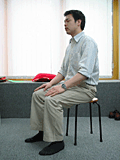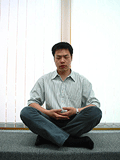| |
Proper body postures and exercise are the preconditions to guarantee smooth respiration and mental relaxation in qi-gong practice. They assist in opening the body's meridians and directing the qi flow. The aim is to adjust the body to the most comfortable posture, including the head, neck, waist, limbs, fingers and organs.The postures commonly assumed are as follows: |
 |
 |
 Normal Sitting Normal Sitting
Sit up right on a chair, with trunk, thighs and legs at a right angle and at a suitable height where the knees are separated shoulder-width apart, and the feet firmly placed on the ground. The torso is at a right angle to the thighs, the hands placed on the knees or thighs naturally. The lower jaw is slightly drawn in, the shoulders relaxed and the chest slightly drawn in. The mouth and eyes are slightly closed, and the tip of the tongue and is raised touching the upper palate.
|
| |
 |
 Cross-legged Cross-legged
Sit upright on a bed or cushion, legs crossed, hands resting in front of the lower abdomen, palms facing upward. The upper part of body is the same as normal sitting style. |
| |
 |
 Supine Supine
Lie on the back, legs straight, and arms resting on the sides. |
| |
 |
 Lying Sideways Lying Sideways
Lie on the bed with the upper body straight and legs slightly bent. Rest the upper hand on the hip and the lower hand palm up on the pillow. The right side is commonly adopted. |
| |
 |
 Standing Standing
Take the tri-round style for an example. Stand erect, feet parallel and apart at about shoulder width with toes pointing slightly inward. Bend knees slightly, hold in chest and raise arms so that hands are no higher than shoulders, elbows drooping slightly, with hands naturally separated and bent as if holding a ball. Head and neck straight, the lower jaw slightly drawn in. Eyes and mouth are slightly closed with a slight smile.
|
| |
 |
Walking
Stand quietly for a few minutes, then move with the left foot forward, heel touching first, body and hands swaying to the right as one moves forward. Breathe in through the nose and out through the mouth. When weight is on left foot, move forward with the right foot, heel first, body and hands swaying left. Walk forward step by step as described above for about half an hour, repeat the same breath technique after each step. |